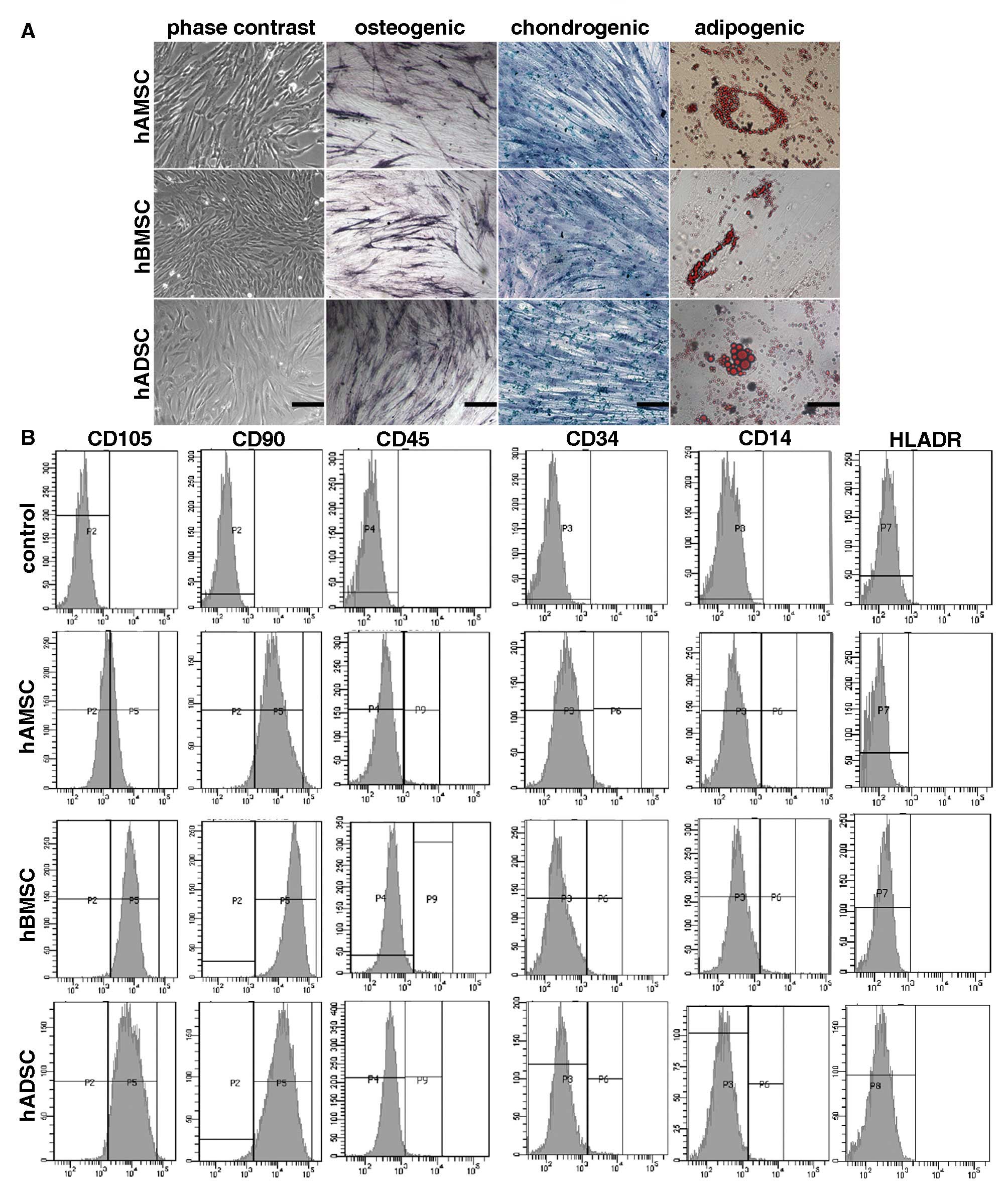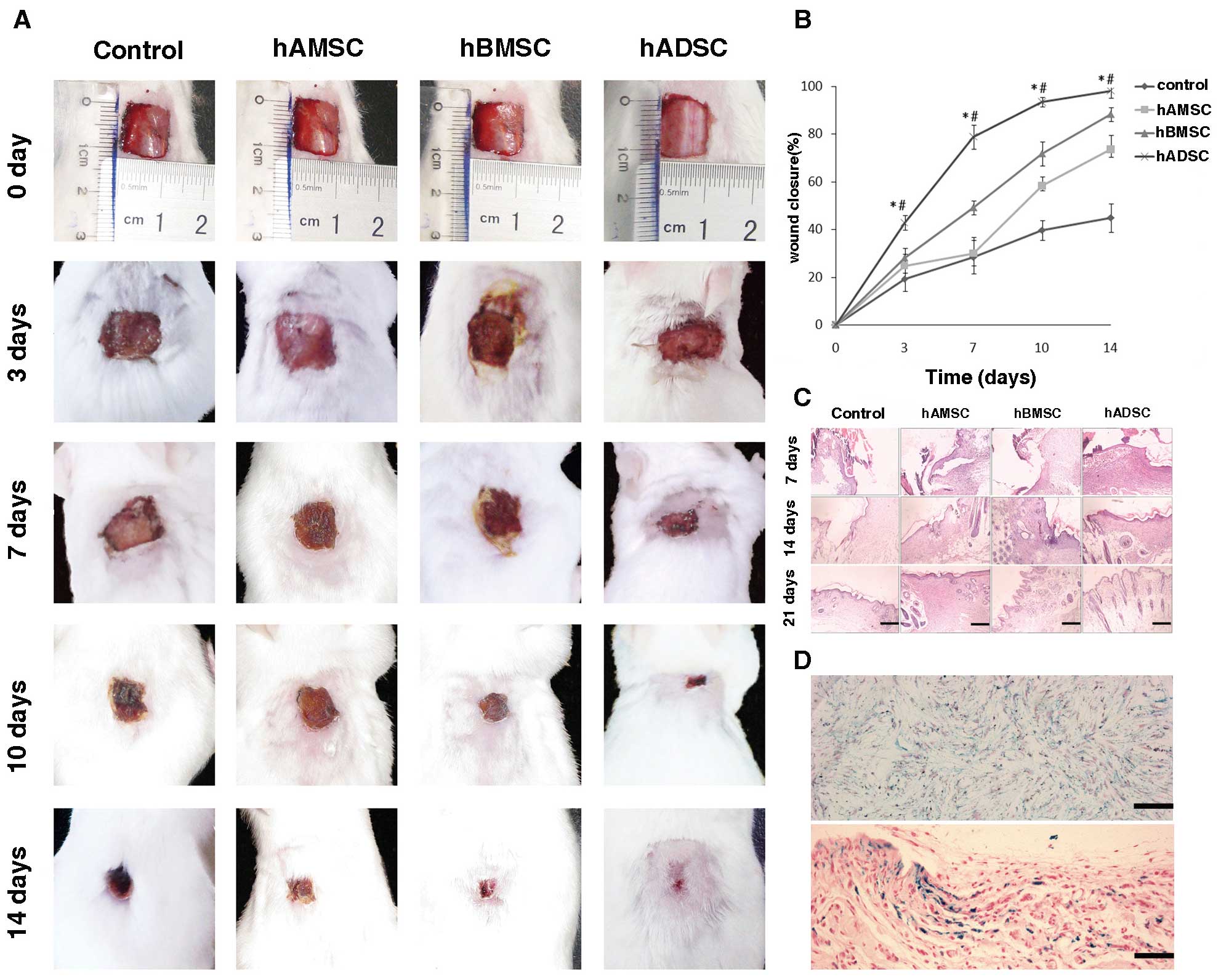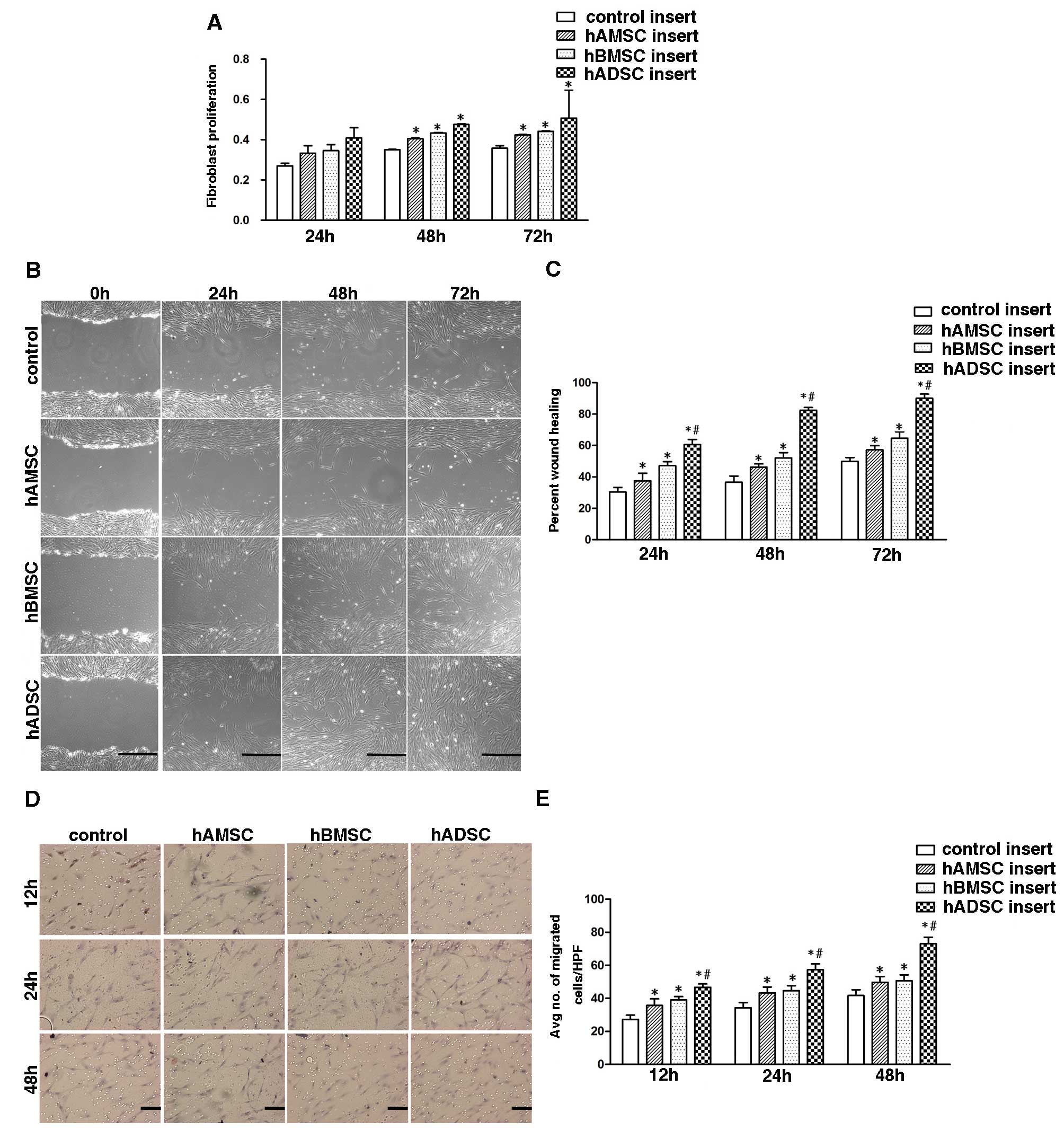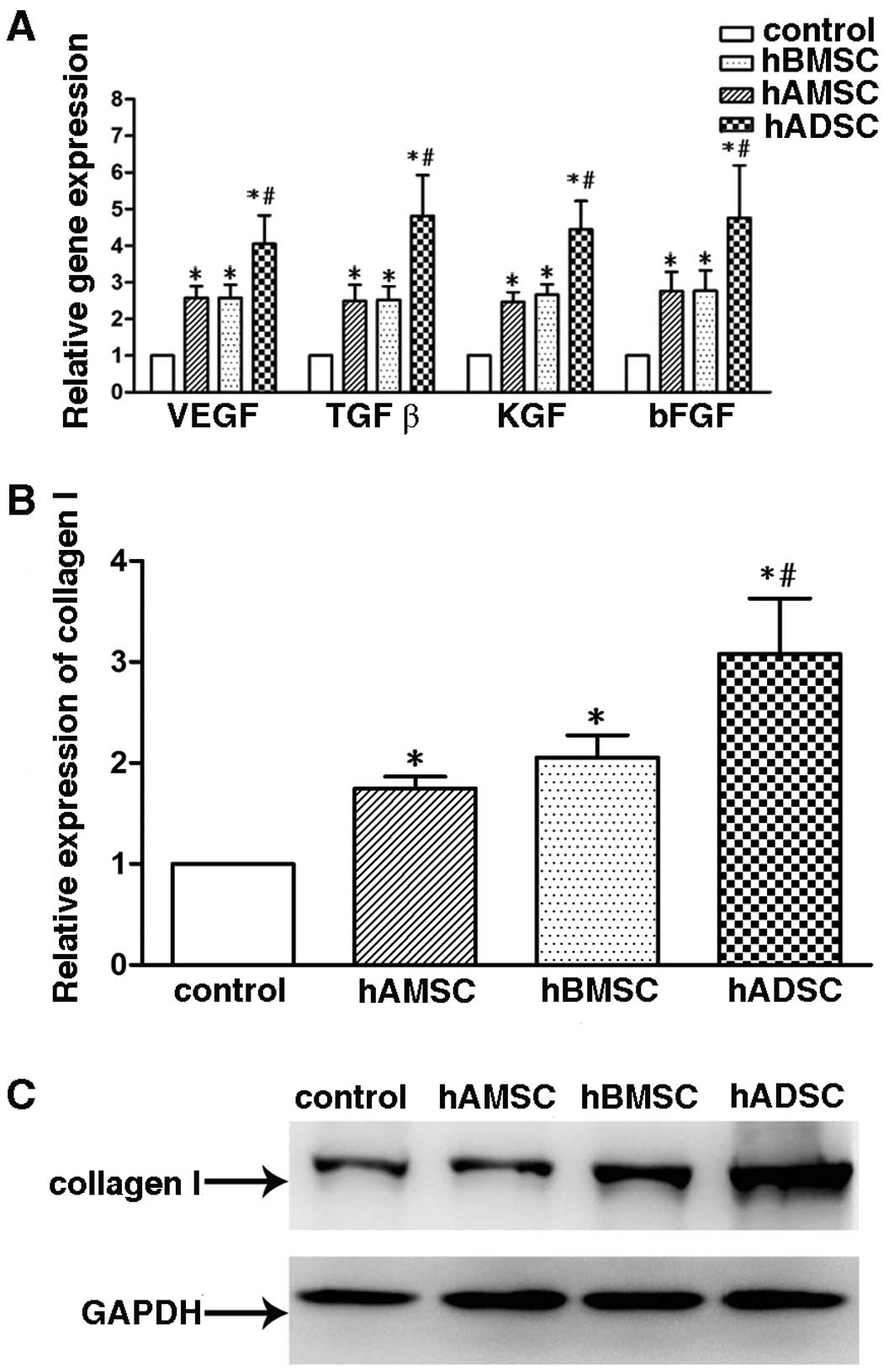|
1.
|
Chen M, Przyborowski M and Berthiaume F:
Stem cells for skin tissue engineering and wound healing. Crit Rev
Biomed Eng. 37:399–421. 2009. View Article : Google Scholar : PubMed/NCBI
|
|
2.
|
Walter MN, Wright KT, Fuller HR, MacNeil S
and Johnson WE: Mesenchymal stem cell-conditioned medium
accelerates skin wound healing: an in vitro study of fibroblast and
keratinocyte scratch assays. Exp Cell Res. 316:1271–1281. 2010.
View Article : Google Scholar : PubMed/NCBI
|
|
3.
|
Han SK, Yoon TH, Lee DG, Lee MA and Kim
WK: Potential of human bone marrow stromal cells to accelerate
wound healing in vitro. Ann Plast Surg. 55:414–419. 2005.
View Article : Google Scholar : PubMed/NCBI
|
|
4.
|
Kim Y, Kim H, Cho H, Bae Y, Suh K and Jung
J: Direct comparison of human mesenchymal stem cells derived from
adipose tissues and bone marrow in mediating neovascularization in
response to vascular ischemia. Cell Physiol Biochem. 20:867–876.
2007. View Article : Google Scholar : PubMed/NCBI
|
|
5.
|
Prockop DJ: Marrow stromal cells as stem
cells for nonhematopoietic tissues. Science. 276:71–74. 1997.
View Article : Google Scholar : PubMed/NCBI
|
|
6.
|
Pittenger MF, Mackay AM, Beck SC, et al:
Multilineage potential of adult human mesenchymal stem cells.
Science. 284:143–147. 1999. View Article : Google Scholar : PubMed/NCBI
|
|
7.
|
Zuk PA, Zhu M, Mizuno H, et al:
Multilineage cells from human adipose tissue: implications for
cell-based therapies. Tissue Eng. 7:211–228. 2001. View Article : Google Scholar : PubMed/NCBI
|
|
8.
|
Safford KM, Hicok KC, Safford SD, et al:
Neurogenic differentiation of murine and human adipose-derived
stromal cells. Biochem Biophys Res Commun. 294:371–379. 2002.
View Article : Google Scholar : PubMed/NCBI
|
|
9.
|
Reyes M, Dudek A, Jahagirdar B, Koodie L,
Marker PH and Verfaillie CM: Origin of endothelial progenitors in
human postnatal bone marrow. J Clin Invest. 109:337–346. 2002.
View Article : Google Scholar : PubMed/NCBI
|
|
10.
|
Smith AN, Willis E, Chan VT, Muffley LA,
Isik FF, Gibran NS and Hocking AM: Mesenchymal stem cells induce
dermal fibroblast responses to injury. Exp Cell Res. 316:48–54.
2010. View Article : Google Scholar : PubMed/NCBI
|
|
11.
|
Xing L, Franz MG, Marcelo CL, Smith CA,
Marshall VS and Robson MC: Amnion-derived multipotent progenitor
cells increase gain of incisional breaking strength and decrease
incidence and severity of acute wound failure. J Burns Wounds.
7:e52007.PubMed/NCBI
|
|
12.
|
Kim SS, Song CK, Shon SK, Lee KY, Kim CH,
Lee MJ and Wang L: Effects of human amniotic membrane grafts
combined with marrow mesenchymal stem cells on healing of
full-thickness skin defects in rabbits. Cell Tissue Res. 336:59–66.
2009. View Article : Google Scholar : PubMed/NCBI
|
|
13.
|
Jung KH, Song SU, Yi T, et al: Human bone
marrow-derived clonal mesenchymal stem cells inhibit inflammation
and reduce acute pancreatitis in rats. Gastroenterology.
140:998–1008. 2011. View Article : Google Scholar : PubMed/NCBI
|
|
14.
|
Saito T, Kuang JQ, Bittira B, Al-Khaldi A
and Chiu RC: Xenotransplant cardiac chimera: immune tolerance of
adult stem cells. Ann Thorac Surg. 74:19–24. 2002. View Article : Google Scholar : PubMed/NCBI
|
|
15.
|
Kim WS, Park BS, Sung JH, et al: Wound
healing effect of adipose-derived stem cells: a critical role of
secretory factors on human dermal fibroblasts. J Dermatol Sci.
48:15–24. 2007. View Article : Google Scholar : PubMed/NCBI
|
|
16.
|
Falanga V, Iwamoto S, Chartier M, et al:
Autologous bone marrow-derived cultured mesenchymal stem cells
delivered in a fibrin spray accelerate healing in murine and human
cutaneous wounds. Tissue Eng. 13:1299–1312. 2007. View Article : Google Scholar : PubMed/NCBI
|
|
17.
|
Javazon EH, Keswani SG, Badillo AT, et al:
Enhanced epithelial gap closure and increased angiogenesis in
wounds of diabetic mice treated with adult murine bone marrow
stromal progenitor cells. Wound Repair Regen. 15:350–359. 2007.
View Article : Google Scholar : PubMed/NCBI
|
|
18.
|
Lin CD, Allori AC, Macklin JE, et al:
Topical lineage-negative progenitor-cell therapy for diabetic
wounds. Plast Reconstr Surg. 122:1341–1351. 2008. View Article : Google Scholar : PubMed/NCBI
|
|
19.
|
Wu Y, Chen L, Scott PG and Tredget EE:
Mesenchymal stem cells enhance wound healing through
differentiation and angiogenesis. Stem Cells. 25:2648–2659. 2007.
View Article : Google Scholar : PubMed/NCBI
|
|
20.
|
Wu Y, Wang JF, Scott PG and Tredget EE:
Bone marrow-derived stem cells in wound healing: a review. Wound
Repair Regen. 15(Suppl 1): S18–S26. 2007. View Article : Google Scholar : PubMed/NCBI
|
|
21.
|
Sasaki M, Abe R, Fujita Y, Ando S, Inokuma
D and Shimizu H: Mesenchymal stem cells are recruited into wounded
skin and contribute to wound repair by transdifferentiation into
multiple skin cell type. J Immunol. 180:2581–2587. 2008. View Article : Google Scholar : PubMed/NCBI
|
|
22.
|
Yoo JH, Park C, Jung DI, et al: In vivo
cell tracking of canine allogenic mesenchymal stem cells
administration via renal arterial catheterization and
physiopathological effects on the kidney in two healthy dogs. J Vet
Med Sci. 73:269–274. 2011. View Article : Google Scholar
|
|
23.
|
Balakumaran A, Pawelczyk E, Ren J, et al:
Superparamagnetic iron oxide nanoparticles labeling of bone marrow
stromal (mesenchymal) cells does not affect their ‘stemness’. PLoS
One. 5:e114622010.
|
|
24.
|
Chen L, Tredget EE, Wu PY and Wu Y:
Paracrine factors of mesenchymal stem cells recruit macrophages and
endothelial lineage cells and enhance wound healing. PLoS One.
3:e18862008. View Article : Google Scholar : PubMed/NCBI
|
|
25.
|
Yu M, Cai L, Liang M, et al: Alteration of
NRSF expression exacerbating 1-methyl-4-phenyl-pyridinium
ion-induced cell death of SH-SY5Y cells. Neurosci Res. 65:236–244.
2009. View Article : Google Scholar : PubMed/NCBI
|
|
26.
|
Li H, Wang L, Ye L, et al: Influence of
Pseudomonas aeruginosa quorum sensing signal molecule
N-(3-oxododecanoyl) homoserine lactone on mast cells. Med Microbiol
Immunol. 198:113–121. 2009.
|
|
27.
|
Cheng Y, Hu R, Jin H, et al: Effect of
14-3-3 tau protein on differentiation in BeWo choriocarcinoma
cells. Placenta. 31:60–66. 2010. View Article : Google Scholar : PubMed/NCBI
|
|
28.
|
Liu S, Yang P, Kang H, et al: NDRG2
induced by oxidized LDL in macrophages antagonizes growth factor
productions via selectively inhibiting ERK activation. Biochim
Biophys Acta. 1801:106–113. 2010. View Article : Google Scholar : PubMed/NCBI
|
|
29.
|
Wagner W, Wein F, Seckinger A, et al:
Comparative characteristics of mesenchymal stem cells from human
bone marrow, adipose tissue, and umbilical cord blood. Exp Hematol.
33:1402–1416. 2005. View Article : Google Scholar : PubMed/NCBI
|
|
30.
|
Hartlapp I, Abe R, Saeed RW, et al:
Fibrocytes induce an angiogenic phenotype in cultured endothelial
cells and promote angiogenesis in vivo. FASEB J. 15:2215–2224.
2001. View Article : Google Scholar : PubMed/NCBI
|
|
31.
|
Martin P: Wound healing-aiming for perfect
skin regeneration. Science. 276:75–81. 1997. View Article : Google Scholar : PubMed/NCBI
|
|
32.
|
Singer AJ and Clark RA: Cutaneous wound
healing. N Engl J Med. 341:738–746. 1999. View Article : Google Scholar : PubMed/NCBI
|
|
33.
|
Shojaku H, Takakura H, Okabe M, Fujisaka
M, Watanabe Y and Nikaido T: Effect of hyperdry amniotic membrane
patches attached over the bony surface of mastoid cavities in canal
wall down tympanoplasty. Laryngoscope. 121:1953–1957.
2011.PubMed/NCBI
|
|
34.
|
Gruss JS and Jirsch DW: Human amniotic
membrane: a versatile wound dressing. Can Med Assoc J.
118:1237–1246. 1978.PubMed/NCBI
|
|
35.
|
Krishnamurithy G, Shilpa PN, Ahmad RE,
Sulaiman S, Ng CL and Kamarul T: Human amniotic membrane as a
chondrocyte carrier vehicle/substrate: in vitro study. J Biomed
Mater Res A. 99:500–506. 2011. View Article : Google Scholar : PubMed/NCBI
|
|
36.
|
McGhee CN and Patel DV: Mooren’s ulcer and
amniotic membrane transplant: a simple surgical solution? Clin
Experiment Ophthalmol. 39:383–385. 2011.
|
|
37.
|
Pessolato AG, Martins Ddos S, Ambrósio CE,
Mançanares CA and de Carvalho AF: Propolis and amnion
reepithelialise second-degree burns in rats. Burns. 37:1192–1201.
2011. View Article : Google Scholar : PubMed/NCBI
|
|
38.
|
Toda A, Okabe M, Yoshida T and Nikaido T:
The potential of amniotic membrane/amnion-derived cells for
regeneration of various tissues. J Pharmacol Sci. 105:215–228.
2007. View Article : Google Scholar : PubMed/NCBI
|
|
39.
|
Chesney J, Metz C, Stavitsky AB, Bacher M
and Bucala R: Regulated production of type I collagen and
inflammatory cytokines by peripheral blood fibrocytes. J Immunol.
160:419–425. 1998.PubMed/NCBI
|
|
40.
|
Belgore F, Lip GY and Blann AD: Basic
fibroblast growth factor induces the secretion of vascular
endothelial growth factor by human aortic smooth muscle cells but
not by endothelial cells. Eur J Clin Invest. 33:833–839. 2003.
View Article : Google Scholar
|
|
41.
|
Zhang F, Oswald T, Lin S, et al: Vascular
endothelial growth factor (VEGF) expression and the effect of
exogenous VEGF on survival of a random flap in the rat. Br J Plast
Surg. 56:653–659. 2003. View Article : Google Scholar : PubMed/NCBI
|
|
42.
|
Yang R, Thomas GR, Bunting S, et al:
Effects of vascular endothelial growth factor on hemodynamics and
cardiac performance. J Cardiovasc Pharmacol. 27:838–844. 1996.
View Article : Google Scholar : PubMed/NCBI
|
|
43.
|
Barrientos S, Stojadinovic O, Golinko MS,
Brem H and Tomic-Canic M: Growth factors and cytokines in wound
healing. Wound Repair Regen. 16:585–601. 2008. View Article : Google Scholar : PubMed/NCBI
|
|
44.
|
Postlethwaite AE, Keski-Oja J, Moses HL
and Kang AH: Stimulation of the chemotactic migration of human
fibroblasts by transforming growth factor beta. J Exp Med.
165:251–256. 1987. View Article : Google Scholar : PubMed/NCBI
|
|
45.
|
Li Y, Fan J, Chen M, Li W and Woodley DT:
Transforming growth factor-alpha: a major human serum factor that
promotes human keratinocyte migration. J Invest Dermatol.
126:2096–2105. 2006. View Article : Google Scholar : PubMed/NCBI
|
|
46.
|
Arnold F and West DC: Angiogenesis in
wound healing. Pharmacol Ther. 52:407–422. 1991. View Article : Google Scholar
|
|
47.
|
Fam NP, Verma S, Kutryk M and Stewart DJ:
Clinician guide to angiogenesis. Circulation. 108:2613–2618. 2003.
View Article : Google Scholar : PubMed/NCBI
|
|
48.
|
Hansen SL, Young DM and Boudreau NJ: HoxD3
expression and collagen synthesis in diabetic fibroblasts. Wound
Repair Regen. 11:474–480. 2003. View Article : Google Scholar : PubMed/NCBI
|


















